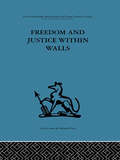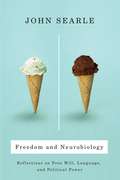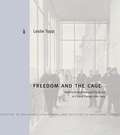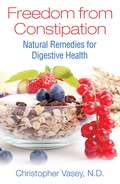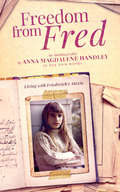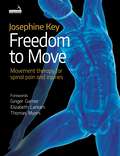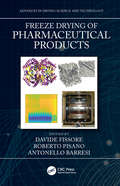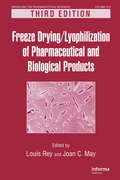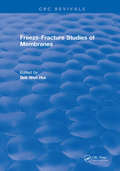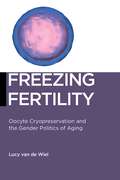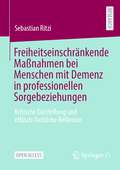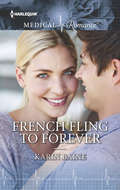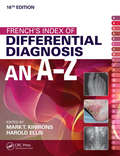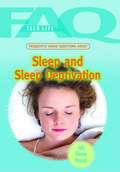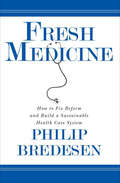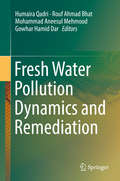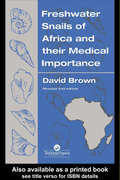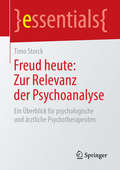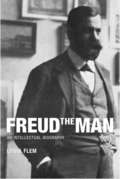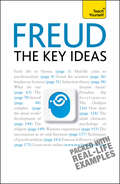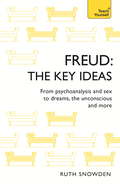- Table View
- List View
Freedom and Justice within Walls: The Bristol Prison experiment (International Behavioural And Social Sciences Ser. #Vol. 18)
by F E EmeryTavistock Press was established as a co-operative venture between the Tavistock Institute and Routledge & Kegan Paul (RKP) in the 1950s to produce a series of major contributions across the social sciences. This volume is part of a 2001 reissue of a selection of those important works which have since gone out of print, or are difficult to locate. Published by Routledge, 112 volumes in total are being brought together under the name The International Behavioural and Social Sciences Library: Classics from the Tavistock Press. Reproduced here in facsimile, this volume was originally published in 1970 and is available individually. The collection is also available in a number of themed mini-sets of between 5 and 13 volumes, or as a complete collection.
Freedom and Neurobiology: Reflections on Free Will, Language, and Political Power
by John R. SearleOur self-conception derives mostly from our own experience. We believe ourselves to be conscious, rational, social, ethical, language-using, political agents who possess free will. Yet we know we exist in a universe that consists of mindless, meaningless, unfree, nonrational, brute physical particles. How can we resolve the conflict between these two visions? In Freedom and Neurobiology, the philosopher John Searle discusses the possibility of free will within the context of contemporary neurobiology. He begins by explaining the relationship between human reality and the more fundamental reality as described by physics and chemistry. Then he proposes a neurobiological resolution to the problem by demonstrating how various conceptions of free will have different consequences for the neurobiology of consciousness. In the second half of the book, Searle applies his theory of social reality to the problem of political power, explaining the role of language in the formation of our political reality. The institutional structures that organize, empower, and regulate our lives-money, property, marriage, government-consist in the assignment and collective acceptance of certain statuses to objects and people. Whether it is the president of the United States, a twenty-dollar bill, or private property, these entities perform functions as determined by their status in our institutional reality. Searle focuses on the political powers that exist within these systems of status functions and the way in which language constitutes them. Searle argues that consciousness and rationality are crucial to our existence and that they are the result of the biological evolution of our species. He addresses the problem of free will within the context of a neurobiological conception of consciousness and rationality, and he addresses the problem of political power within the context of this analysis. A clear and concise contribution to the free-will debate and the study of cognition, Freedom and Neurobiology is essential reading for students and scholars of the philosophy of mind.
Freedom and Neurobiology: Reflections on Free Will, Language, and Political Power (Columbia Themes in Philosophy)
by John SearleOur self-conception derives mostly from our own experience. We believe ourselves to be conscious, rational, social, ethical, language-using, political agents who possess free will. Yet we know we exist in a universe that consists of mindless, meaningless, unfree, nonrational, brute physical particles. How can we resolve the conflict between these two visions?In Freedom and Neurobiology, the philosopher John Searle discusses the possibility of free will within the context of contemporary neurobiology. He begins by explaining the relationship between human reality and the more fundamental reality as described by physics and chemistry. Then he proposes a neurobiological resolution to the problem by demonstrating how various conceptions of free will have different consequences for the neurobiology of consciousness. In the second half of the book, Searle applies his theory of social reality to the problem of political power, explaining the role of language in the formation of our political reality. The institutional structures that organize, empower, and regulate our lives-money, property, marriage, government-consist in the assignment and collective acceptance of certain statuses to objects and people. Whether it is the president of the United States, a twenty-dollar bill, or private property, these entities perform functions as determined by their status in our institutional reality. Searle focuses on the political powers that exist within these systems of status functions and the way in which language constitutes them.Searle argues that consciousness and rationality are crucial to our existence and that they are the result of the biological evolution of our species. He addresses the problem of free will within the context of a neurobiological conception of consciousness and rationality, and he addresses the problem of political power within the context of this analysis. A clear and concise contribution to the free-will debate and the study of cognition, Freedom and Neurobiology is essential reading for students and scholars of the philosophy of mind.
Freedom and the Cage: Modern Architecture and Psychiatry in Central Europe, 1890–1914 (Buildings, Landscapes, and Societies #10)
by Leslie ToppSpurred by ideals of individual liberty that took hold in the Western world in the late nineteenth century, psychiatrists and public officials sought to reinvent asylums as large-scale, totally designed institutions that offered a level of freedom and normality impossible in the outside world. This volume explores the “caged freedom” that this new psychiatric ethos represented by analyzing seven such buildings established in the Austro-Hungarian monarchy between the late 1890s and World War I.In the last two decades of the Habsburg Empire, architects of asylums began to abandon traditional corridor-based plans in favor of looser formations of connected villas, echoing through design the urban- and freedom-oriented impulse of the progressive architecture of the time. Leslie Topp considers the paradoxical position of designs that promoted an illusion of freedom even as they exercised careful social and spatial control over patients. In addition to discussing the physical and social aspects of these institutions, Topp shows how the commissioned buildings were symptomatic of larger cultural changes and of the modern asylum’s straining against its ideological anchorage in a premodern past of “unenlightened” restraint on human liberty.Working at the intersection of the history of architecture and the history of psychiatry, Freedom and the Cage broadens our understanding of the complexity and fluidity of modern architecture’s engagement with the state, with social and medical projects, and with mental health, psychiatry, and psychology.
Freedom and the Cage: Modern Architecture and Psychiatry in Central Europe, 1890–1914 (Buildings, Landscapes, and Societies #10)
by Leslie ToppSpurred by ideals of individual liberty that took hold in the Western world in the late nineteenth century, psychiatrists and public officials sought to reinvent asylums as large-scale, totally designed institutions that offered a level of freedom and normality impossible in the outside world. This volume explores the “caged freedom” that this new psychiatric ethos represented by analyzing seven such buildings established in the Austro-Hungarian monarchy between the late 1890s and World War I.In the last two decades of the Habsburg Empire, architects of asylums began to abandon traditional corridor-based plans in favor of looser formations of connected villas, echoing through design the urban- and freedom-oriented impulse of the progressive architecture of the time. Leslie Topp considers the paradoxical position of designs that promoted an illusion of freedom even as they exercised careful social and spatial control over patients. In addition to discussing the physical and social aspects of these institutions, Topp shows how the commissioned buildings were symptomatic of larger cultural changes and of the modern asylum’s straining against its ideological anchorage in a premodern past of “unenlightened” restraint on human liberty.Working at the intersection of the history of architecture and the history of psychiatry, Freedom and the Cage broadens our understanding of the complexity and fluidity of modern architecture’s engagement with the state, with social and medical projects, and with mental health, psychiatry, and psychology.
Freedom from Constipation: Natural Remedies for Digestive Health
by Christopher VaseyA practical guide to discovering the cause of your constipation and finding the right natural remedy for your unique case • Details the 8 main causes of constipation and how to determine which is at the root of your difficulties • Offers practical advice on how to correct each type of constipation with natural and non-aggressive methods, such as dietary changes, herbs, and relaxation methods • Explains gentle, natural ways to empty the bowels when quick relief is necessary • Reveals how treating constipation properly can restore full function not only to the digestive system but to the liver and kidneys as well Constipation has many causes. Most people do not know the exact cause of their constipation and thus have trouble finding lasting relief. Yet there are many natural remedies available that can be tailored to your body’s specific needs. In this step-by-step guide, Christopher Vasey explains how healthy intestines work and the different forms that constipation can take. He details the 8 main causes of constipation: lack of roughage, lack of water, liver dysfunction, constipating foods or medications, weak muscles, imbalances in intestinal flora, stress and anxiety, and nutritional deficiencies. He helps you discover which of the 8 causes underlies your unique case and offers practical advice on how to correct it with natural and non-aggressive methods, such as dietary changes, herbs, and relaxation techniques. For situations when quick relief is necessary, he provides gentle ways to empty the bowels, including natural laxatives and enemas, explaining which to choose for each type of constipation, but also stressing that these are only temporary solutions. Explaining how constipation can be a symptom of a deeper imbalance, the author explores how treating it properly can restore full function not only to the digestive system but to the liver and kidneys as well. In this practical guide, you will learn how to support the work of your intestines, allowing your body to gradually resume its natural working rhythm.
Freedom from Fred: Living with Friedreich's Ataxia
by Anna Magdalene HandleyOn the night of a debutante ball, events set in motion an emotive and intimate portrayal of the revelation of a life changing condition. Anna Magdalene plunges deep into a personal maelstrom that is both tender and hard-hitting as it explores the hidden recesses of social understanding of her condition, Friedreich's Ataxia. On the quest for healing, Anna embarks on brave and sometimes strange journeys of enlightenment to free herself from the bonds of her condition. In one of these adventures she stumbles on an unexpected answer that brings a true light in the most disarming way, changing her whole view of what freedom is. Simultaneously, she discovers a mutual hope to join life again and a way to live with her condition, 'Fred', while she must. (Blurb by Anna's Carers, Pierre and Lee Figueira)
Freedom to Move: Movement Therapy for Spinal Pain and Injuries
by Josephine KeyFreedom to Move is an evidence informed practical resource which provides movement therapists of all disciplines with an exercise blueprint for rehabilitating spinal pain and many related 'injuries'.In essence, Freedom to Move describes what goes wrong in the spine and what to do about it. It integrates the applicable contemporary neuroscience around spinal movement and pain with the clinical evidence and understanding gained from the author's enquiring practice, and her exploration of various movement approaches and their contribution - or otherwise, to spinal well-being.It examines the relationship between healthy torso structure and functional control and describes and explains the author's model of spinal dysfunction - the remediation of which forms the basis of the author's model of care for the spine, The Key Approach®.The book's main focus is on a practical, therapeutic exercise/movement approach which addresses the common movement faults and dysfunctions observed in people with spinal pain and stiffness.In particular, the Fundamental Patterns of control are introduced as important, innate 'key' movements which naturally provide the sound foundations necessary for a healthy spine - but which have commonly been 'lost' in the movement repertoire of people with spinal pain syndromes.These are re-established and reincorporated into various poses, movements and stretches by way of specifically directed mindful movement explorations. The client is helped to regain more optimal function and move out of pain - with more freedom.The approach is applicable within all industry models of teaching therapeutic movement: in the rehabilitation of spinal pain within physiotherapy, Pilates and Yoga; and in the fitness industry, for injury prevention, health promotion and optimising spinal health in exercise programmes in general.
Freeze Drying of Pharmaceutical Products (Advances in Drying Science and Technology)
by Davide Fissore Roberto Pisano Antonello BarresiFreeze Drying of Pharmaceutical Products provides an overview of the most recent and cutting-edge developments and technologies in the field, focusing on formulation developments and process monitoring and considering new technologies for process development. This book contains case studies from freeze dryer manufacturers and pharmaceutical companies for readers in industry and academia. It was contributed to by lyophilization experts to create a detailed analysis of the subject matter, organically presenting recent advancements in freeze-drying research and technology. It discusses formulation design, process optimization and control, new PAT-monitoring tools, multivariate image analysis, process scale-down and development using small-scale freeze-dryers, use of CFD for equipment design, and development of continuous processes. This book is for industry professionals, including chemical engineers and pharmaceutical scientists.
Freeze-Drying/Lyophilization of Pharmaceutical and Biological Products (Drugs and the Pharmaceutical Sciences)
by Louis Rey Joan C. MayFreeze-drying, or lyophilization, is a well established technology used in the preservation of numerous pharmaceutical and biological products. This highly effective dehydration method involves the removal of water from frozen materials via the direct sublimation of ice. In recent years, this process has met with many changes, as have the regulatio
Freeze-Fracture Studies of Membranes
by Sek Wen HuiThis volume is a kind of celebration of the progress of freeze-fracture electron microscopy in recent years. Many of the authors are leaders of the advancing front. Instead of offering an instruction manual of how to perform new techniques or a review to recover what has happened in the past in respect fields, both which are abundantly available as journal articles and monographs, this volume is a collection of personal testimonies as examples of the power of the new freeze-fracture technology. Since each chapter also centres around specific biological problem, it also serves to illustrate how much the understanding of the problem has been advanced by the new freeze-fracture methodology, which is most cases is developed by the author(s) themselves. A characteristic of frontier development is that many chapters are dealing with controversial subjects. The Inclusion of these subjects in the volume represents the dynamic nature of the subject as viewed by the authors rather than the final verdicts of the subject matter.
Freezing Fertility: Oocyte Cryopreservation and the Gender Politics of Aging (Biopolitics #22)
by Lucy van de WielWelcomed as liberation and dismissed as exploitation, egg freezing (oocyte cryopreservation) has rapidly become one of the most widely-discussed and influential new reproductive technologies of this century. In Freezing Fertility, Lucy van de Wiel takes us inside the world of fertility preservation—with its egg freezing parties, contested age limits, proactive anticipations and equity investments—and shows how the popularization of egg freezing has profound consequences for the way in which female fertility and reproductive aging are understood, commercialized and politicized.Beyond an individual reproductive choice for people who may want to have children later in life, Freezing Fertility explores how the rise of egg freezing also reveals broader cultural, political and economic negotiations about reproductive politics, gender inequities, age normativities and the financialization of healthcare. Van de Wiel investigates these issues by analyzing a wide range of sources—varying from sparkly online platforms to heart-breaking court cases and intimate autobiographical accounts—that are emblematic of each stage of the egg freezing procedure. By following the egg’s journey, Freezing Fertility examines how contemporary egg freezing practices both reflect broader social, regulatory and economic power asymmetries and repoliticize fertility and aging in ways that affect the public at large. In doing so, the book explores how the possibility of egg freezing shifts our relation to the beginning and end of life.
Freiheitseinschränkende Maßnahmen bei Menschen mit Demenz in professionellen Sorgebeziehungen: Kritische Darstellung und ethisch-fachliche Reflexion
by Sebastian RitziDieses Open-Access-Buch befasst sich kritisch mit der Anwendung freiheitseinschränkender Maßnahmen (FeM) bei Menschen mit Demenz in professionellen Sorgebeziehungen, die sowohl im Hinblick auf ihren vermeintlichen Nutzen als auch auf ihre ethische Tragweite zu hinterfragen sind. In einer disziplinübergreifenden Analyse des Phänomens von FeM bei Menschen mit Demenz werden Diskurse und Erkenntnisse aus Pflegewissenschaft, Gerontologie, Rechtswissenschaft und Ethik gebündelt, zueinander in Beziehung gesetzt und erweitert. Die empirisch informierte Gesamtdarstellung wird dabei ergänzt durch eine tiefgreifende Reflexion der Personalität, Vulnerabilität und Leiblichkeit von Menschen mit Demenz. Davon ausgehend werden konkrete Kategorien und konzeptionelle Zugänge zur Bewertung und Einzelfallprüfung von FeM in professionellen Sorgebeziehungen entwickelt.
French Fling to Forever
by Karin BaineA very French temptation... Junior doctor Lola Roberts finally has her life back on track-and she's determined not to mess up on her first day at a Belfast hospital. Although she certainly didn't expect her sexy French boss Dr. Henri Benoit to prove her greatest distraction... Henri ruled out forever a long time ago, but surely a six-week fling with pretty, pink-stethoscope-wielding Lola can't hurt? Yet as Lola begins to melt the barriers around his locked-away heart, Henri realizes he never wants to let her go!
French's Index of Differential Diagnosis An A-Z 1: An A-z
by Harold Ellis Mark KinironsFirst published in 1912, French's Index of Differential Diagnosis helps clinicians in the differential diagnosis of any condition which may be seen in hospital or general practice. Arranged alphabetically by symptom, the text helps readers identify each presentation, describes the different diagnoses that it could represent, and explains the tests
Frequently Asked Questions about Sleep and Sleep Deprivation
by Judy Monroe PetersonThe book describes the importance of sleep and its effects on the body, including common sleeping disorders, why some people do not get enough sleep, and medical aids for sleeping.
Fresh Medicine: How to Fix, Reform, and Build a Sustainable Health Care System (Books That Changed the World)
by Phil BredesenAn authoritative, engaging, and nonpartisan look at what is wrong with American health care and how we can fix it—“told with skill and grace” (Jon Meacham, author of American Lion).Former Governor of Tennessee and CEO of HealthAmerica Corporation, Phil Bredesen “knows the American health care system inside and out. He knows both the theory and, more importantly, how things really work.” In Fresh Medicine, he analyses the current state of American Health Care, beginning with a clear-eyed critique of the Affordable Care Act (Bill Frist, M.D., former Senate majority leader).According to Bresden, the Obama Administration ushered million more people into a broken system while doing little to address the underlying problems. Looking back over the past century, Bresden explains how that system developed from local doctors making house calls to today’s sprawling insurance model. What began as an insurance system to cover hospitalization has expanded to cover drugs, doctor visits, and the treatment of chronic disease. American health care, Bredesen asserts, needs to be reset on a new foundation. In Fresh Medicine, he harnesses thirty years of experience to offer a new solution.
Fresh Water Pollution Dynamics and Remediation
by Humaira Qadri Rouf Ahmad Bhat Mohammad Aneesul Mehmood Gowhar Hamid DarFreshwater is a finite resource and is being deteriorated directly and indirectly by anthropogenic pressures. Preserving the quality and availability of freshwater resources is becoming one of the most pressing environmental challenges on the international horizon. To ensure the preservation as well as availability of freshwater resources, there is a need to understand the ecology of the freshwater systems, pollution problems, their impacts, restoration techniques to be opted and the conservation measures. In this backdrop the present book on ‘Freshwater Pollution Dynamics and Remediation’ has been compiled. The book provides an understanding about the present state of art, pollution impacts including the changes in the environmental quality as well as the shift in the aquatic biological communities of the fragile freshwater ecosystems. Besides, the impact of deteriorating quality of the freshwater ecosystems on the animal and human health is also discussed in detail. This book provides a comprehensive account of the techniques based on updated research in biotechnology, bio-remediation, phyto-remediation and nano-bioremediation. The role of biosorpers and biofilms as a remediation tool has also been detailed. The book is a ready reference for researchers, scientists and educators who are involved in the freshwater pollution, remediation and management studies. The book editors with an expertise in diverse research fields in freshwater ecosystems have congregated the most inclusive research accounts on the freshwater pollution and remediation and thus developed a repository of diverse knowledge on the subject
Freshwater Snails Of Africa And Their Medical Importance
by David S BrownThe first half of this book is primarily a systematic survey of the snails, beginning with glossaries, keys for identification to genera and a checklist of species. This is followed by a synopsis of species, with brief notes on ecology, distribution and parasites. Relationships are then described between snails and schistosomes and with other paras
Freud heute: Ein Überblick Für Psychologische Und Ärztliche Psychotherapeuten (essentials)
by Timo StorckTimo Storck prüft in diesem essential die zeitgenössische Relevanz psychoanalytischen Denkens und berührt dabei das psychoanalytische Menschenbild anhand der wichtigsten Konzepte, den Charakter der Psychoanalyse als Behandlungsverfahren sowie den Transfer psychoanalytischer Methodik auf außerklinische Bereiche, insbesondere Kunst und Kultur. Ein wichtiges Anliegen ist ihm dabei eine kritische Darstellung der Psychoanalyse „mit Freud über Freud hinaus“, sodass sich die folgende Frage stellt: Was am Freud’schen Denken behält Bestand und bewährt sich für einen Verstehenszugang des Menschen heute? Die Freud’sche Psychoanalyse gehört zu den meistdiskutierten Aspekten der mitteleuropäischen Kulturgeschichte der vergangenen rund 120 Jahre.
Freud the Man: An Intellectual Biography
by Lydia FlemThe world knows Freud as a thinker--one of the founding giants of modern culture. Now Lydia Flem paints a unique and unforgettable portrait of Frued the man: a father, husband, and friend, a secular Jew with passion for classical antiquity and European culture, torn between his need to be fully accepted in an anitsemitic society while remaining fatihful to his orgins.Flem enters into the depths of Freud's creativity, showing how his thinking is connected to his immersion in the arts, the history of religions, and mythology. The intimate details of his daily life, his relationships with women, his poetic gifts, his travels, his dreams, his letters to family, friends, and colleagues: all reveal his vision of the unconscious. We accompany Freud on his walks through Vienna and Rome; look over his shoulder as he writes to his fiancee; learn the significance of the Greek, Roman, and Egyptian figurines that stand before him on his desk as he conceives his groundbreaking ideas; and discover the books, read in childhood, that later shape his self-analysis and his theoretical development.Flem draws on an unusually broad range of sources, but she wears her learning lightly: her biography of Freud reads like a novel, full of vivid details and captivating human interest. From the 6-year-old gleefully tearing up a book illustrated with pictures of Persia; to the young doctor balancing his scientific training with his love of Shakespeare; to the psychoanalyst in his prime, conquering the resistance to his theories; to the old man, ravaged by illness, forced to flee into exile in England, Lydia Flem leads us deep into the life of a genius.
Freud: Psychoanalysis, dreams, the unconscious and more
by Ruth SnowdenReading the complete works of Sigmund Freud would take more time than most of us have to spare. Freud - the Key Ideas condenses all the information you need about the life and work of the great man into one book. With clear explanations and examples drawn from Freud's own cases you will soon have a solid understanding of the main concepts, from psychosexual development to dream analysis.NOT GOT MUCH TIME?One, five and ten-minute introductions to key principles to get you started.AUTHOR INSIGHTSLots of instant help with common problems and quick tips for success, based on the author's many years of experience.TEST YOURSELFTests in the book and online to keep track of your progress.EXTEND YOUR KNOWLEDGEExtra online articles at www.teachyourself.com to give you a richer understanding of Freud.FIVE THINGS TO REMEMBERQuick refreshers to help you remember the key facts.TRY THISInnovative exercises illustrate what you've learnt and how to use it.
Freud: Psychoanalysis, dreams, the unconscious and more (TY Philosophy)
by Ruth SnowdenReading the complete works of Sigmund Freud would take more time than most of us have to spare. Freud - the Key Ideas condenses all the information you need about the life and work of the great man into one book. With clear explanations and examples drawn from Freud's own cases you will soon have a solid understanding of the main concepts, from psychosexual development to dream analysis.NOT GOT MUCH TIME?One, five and ten-minute introductions to key principles to get you started.AUTHOR INSIGHTSLots of instant help with common problems and quick tips for success, based on the author's many years of experience.TEST YOURSELFTests in the book and online to keep track of your progress.EXTEND YOUR KNOWLEDGEExtra online articles at www.teachyourself.com to give you a richer understanding of Freud.FIVE THINGS TO REMEMBERQuick refreshers to help you remember the key facts.TRY THISInnovative exercises illustrate what you've learnt and how to use it.
Freud: Psychoanalysis, dreams, the unconscious and more (TY Philosophy)
by Ruth SnowdenReading the complete works of Sigmund Freud would take more time than most of us have to spare. Freud - the Key Ideas condenses all the information you need about the life and work of the great man into one book. With clear explanations and examples drawn from Freud's own cases you will soon have a solid understanding of the main concepts, from psychosexual development to dream analysis.AUTHOR INSIGHTSLots of instant help with common problems and quick tips for success, based on the author's many years of experience.TEST YOURSELFTests in the book and online to keep track of your progress.EXTEND YOUR KNOWLEDGEExtra online articles at www.teachyourself.com to give you a richer understanding of Freud.FIVE THINGS TO REMEMBERQuick refreshers to help you remember the key facts.TRY THISInnovative exercises illustrate what you've learnt and how to use it.
Freud: Psychoanalysis, dreams, the unconscious and more (Teach Yourself Philosophy Ser.)
by Ruth SnowdenReading the complete works of Sigmund Freud would take more time than most of us have to spare. Freud - the Key Ideas condenses all the information you need about the life and work of the great man into one book. With clear explanations and examples drawn from Freud's own cases you will soon have a solid understanding of the main concepts, from psychosexual development to dream analysis.AUTHOR INSIGHTSLots of instant help with common problems and quick tips for success, based on the author's many years of experience.TEST YOURSELFTests in the book and online to keep track of your progress.EXTEND YOUR KNOWLEDGEExtra online articles at www.teachyourself.com to give you a richer understanding of Freud.FIVE THINGS TO REMEMBERQuick refreshers to help you remember the key facts.TRY THISInnovative exercises illustrate what you've learnt and how to use it.
